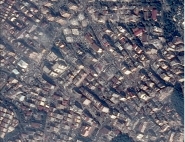September 19, 2014
Hydrological risks
| Over the last twenty years, flooding has occurred repeatedly in all industrial countries. More than 50% of all natural disasters throughout the world are caused by flooding, i.e. 20,000 deaths per year on average. In France, out of 160,000 km of rivers and streams, a surface of 22,000 km² is acknowledged to be particularly subject to flooding, distributed over 7600 towns and representing a population of 2 million shoreline residents. | ||
In terms of hazard assessment, surveillance, prediction and prevention and the management of hydrological risks, the information supplied by the Pleiades data will be useful in several ways:
- at prevention level:
- at prediction level:
- by information on land use (which "strengthens" the run-off coefficient assessments),
- by detecting rises in water level in reservoirs and dams,
- by drawing up maps of soil moisture,
- by drawing up early indicators of deterioration or risks of flooding (changes in land use or morphology)
- at crisis management level by knowledge of the extent of flooded areas in real time,
- and at post-crisis management level by assessing the damage and the geographical extent (maximum if possible) of the floods, and a damage report and inventory.
Published in:
